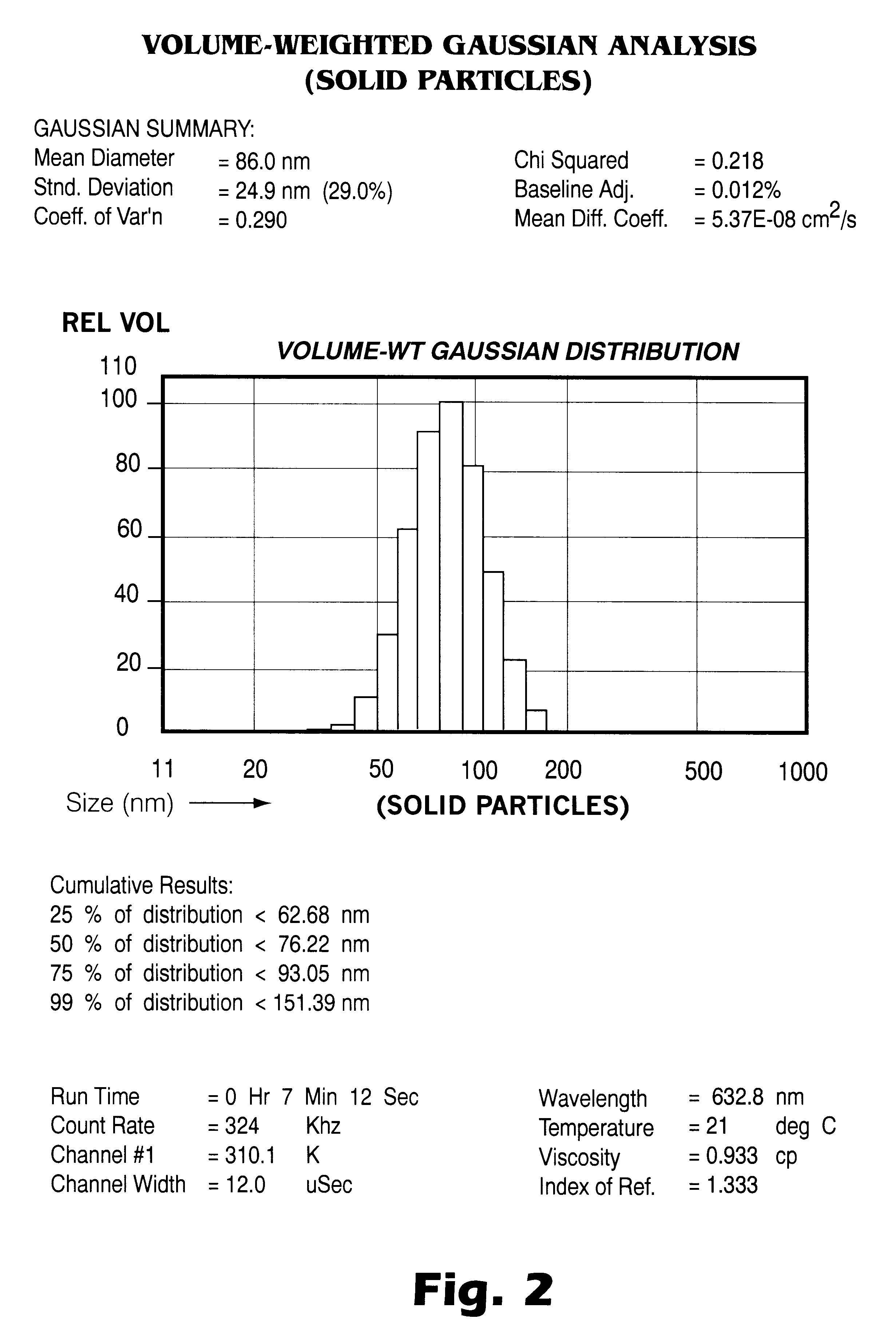Processes to generate submicron particles of water-insoluble compounds
a technology of submicron particles and water-soluble compounds, which is applied in the direction of microcapsules, chemical/physical processes, powder delivery, etc., can solve the problems of drug insolubility, drug insolubility is one of the most recalcitrant, and the solubility or insolubility of water is poor and erratic, etc., to achieve the effect of rapid production of surface stabilized nanometers, inhibiting crystal growth, and high process productivity
- Summary
- Abstract
- Description
- Claims
- Application Information
AI Technical Summary
Benefits of technology
Problems solved by technology
Method used
Image
Examples
example 2
Fenofibrate Microparticle Formation by the RELGS Process
A solution containing Fenofibrate (2 g), Lipoid E-80 (0.2 g), Tween-80 (0.2 g) in the liquefied carbon dioxide pressurized to 3000 psi was expanded through a 50 mm orifice plate into water held at atmospheric pressure and room temperature (22.degree. C.). A fine suspension of fenofibrate was obtained with a mean particle size of about 200 nm. The particle sizing was performed by photon correlation spectroscopy using Submicron Particle Sizer-Autodilute Model 370 (NICOMP Particle Sizing Systems, Santa Barbara, Calif.). This instrument provides number weighted, intensity weighted, and volume weighted particle size distributions as well as multi-modality of the particle size distribution, if present.
example 3
A fine spray-nozzle was constructed with PEEK capillary tubing of an internal diameter of 63.5 mm. This PEEK nozzle was fastened with a M-100 Minitight male nut and attached to an Upchurch SS20V union body which was further attached to a 1 / 4 inch high pressure manifold via Swagelok.TM. brand fittings of appropriate size. Except for the PEEK tubing all other components were made up of 316 stainless steel. A liquefied gas solution of the water insoluble substance was introduced at high pressure (>1000 psig) through the 1 / 4 inch high pressure manifold into the 63.5 mm PEEK nozzle to be expanded into the aqueous medium. The vessel for the liquefied gas solution was charged with 1 g of cyclosporine and 0.2 g of Tween-80. The vessel was filled with carbon dioxide at 5000 psig and heated to about 24.degree. C. The vessel was allowed to stand for about 20 minutes for complete dissolution and for attaining equilibrium. Separately, a 2% w / w suspension of egg phospholipid (Lipoid E80 from Lipo...
example 4
Cyclosporine Microparticle Formation by the RELGS-H Process
An aqueous suspension containing Mannitol (5.5%), Lipoid E-80 (2%), and Tween 80 (2%), was prepared. A solution of cyclosporine in the Liquifed gas was also prepared and kept at 2000 psig and 60.degree. C. This solution was expanded through a 63.5 mm PEEK nozzle into the aqueous suspension. A suspension of about 3 g cyclosporine was made in this way. The resulting suspension was homogenized for 8 passes at 6,000 psig. The final mean particle size after homogenization was 86 nanometers with the 99 percentile at 150 nm (see FIG. 2) as measured using the Submicron Particle Sizer-Autodilute Model 370 (NICOMP Particle Sizing Systems, Santa Barbara, Calif.).
PUM
| Property | Measurement | Unit |
|---|---|---|
| Fraction | aaaaa | aaaaa |
| Fraction | aaaaa | aaaaa |
| Size | aaaaa | aaaaa |
Abstract
Description
Claims
Application Information
 Login to View More
Login to View More - R&D
- Intellectual Property
- Life Sciences
- Materials
- Tech Scout
- Unparalleled Data Quality
- Higher Quality Content
- 60% Fewer Hallucinations
Browse by: Latest US Patents, China's latest patents, Technical Efficacy Thesaurus, Application Domain, Technology Topic, Popular Technical Reports.
© 2025 PatSnap. All rights reserved.Legal|Privacy policy|Modern Slavery Act Transparency Statement|Sitemap|About US| Contact US: help@patsnap.com


